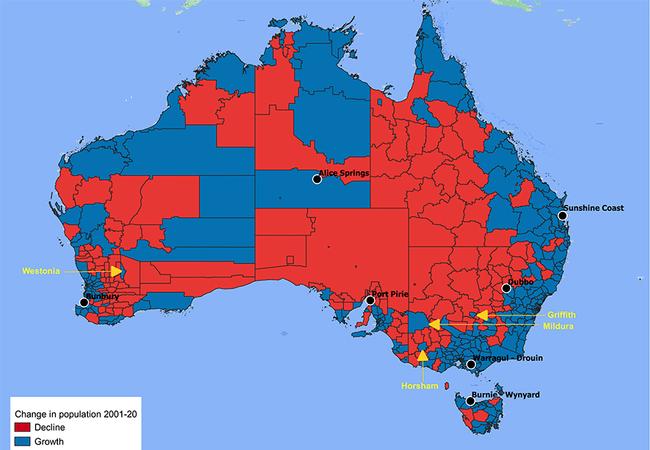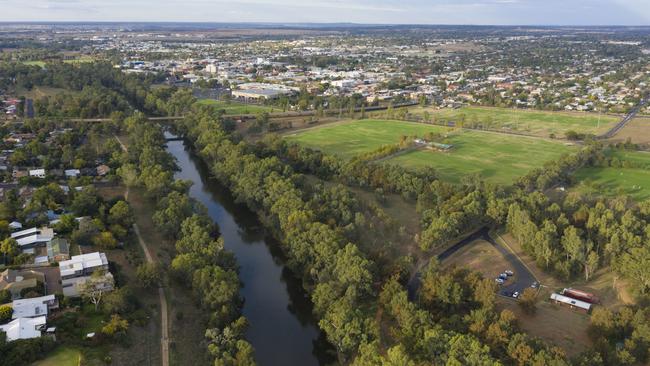Australians on the move in search of opportunities
The great migration from the regions continues – with notable exceptions.

It is a reasonable question to ask: what have the Australian people done with the Australian continent during the early decades of the 21st century? And what are the property implications for the 2020s?
On the move
I have constructed a map of population change across Australia in net terms between 2001 and last year by local government area.
This map says much about Australia and Australians. But best of all it reveals the trials and the transformations that come with a life well lived in regional Australia.
Australia is an immigrant nation. Indeed, about four million of the seven million added in net terms to our national population since 2000 have derived from overseas. Generally immigrants initially remain in capital cities, where support networks are strongest.
But there is another grand population movement that is evident in this map: it is the shifting and shuffling of the Australian people from the regions to the capital cities and to so-called Goldilocks zones (up to 150km of capital city CBD).
I suspect that much of this movement is driven by the pursuit of job opportunities, education and training and the Australian ideal of lifestyle.
Megatrends shaping us
Across the first two decades of the 21st century Australians have retreated from the interior, from the western slopes of the Great Dividing Range, from the Wimmera, the Mallee, from parts of the Riverina, the Eyre and the Yorke peninsulas, from the wheatbelt of Western Australia and of course from vast swathes of the Outback.
Previous generations settled the interior. We’re retreating not so much because we’ve been beaten by the vicissitudes of rural life but because we’ve developed new priorities and ways of earning a living.
Farm mechanisation has facilitated economies of scale, reduced demand for labour and delivered productivity. However, a by-product of this process has been the de-peopling of the interior across time.
Nevertheless, there are growth hot spots in the form of (blue) towns and cities that sit within a broader (red) region of population decline. Here are places that soak up the population of the surrounding farmlands.
Not every resident of regional Australia wants to retire to the Gold Coast. Many want to stay put in places such as Griffith (NSW), Mildura (Victoria), Horsham (Victoria) and Westonia (WA) as well as in many other towns not captured at this LGA scale.

Rites of passage
Large parts of the Australian interior attracted net migration from capital cities (and direct from overseas) right up until the 1970s.
This movement was given impetus by soldier settlement programs after each war.
But by a generation later (by, say, the mid-’70s) the next generation of young Australians had developed different ideals.
Many moved to capital cities for job opportunities, education and training. After all, university education was fee-free for much of the ’70s and ’80s.
Global pressures for economies of scale led to farm aggregation. Australian farms became bigger, mechanised, and required less labour. These trends de-energised small towns, which in turn triggered the flight of youth as a rite of passage.
Yet, despite these forces, the map shows there is growth, but mostly within lifestyle zones outside capital cities. These are the collective sea-change and tree-change communities that huddle around our biggest cities.
These zones are as evident around Hobart (Huon Valley) as they are around Adelaide (Barossa, Fleurieu) Perth (“up the coast”, “down the coast”), Melbourne (Daylesford, Mornington Peninsula), Sydney (Bowral, Central Coast) and Brisbane (either of the coasts).
The exception to this trend is the Northern Rivers of NSW, which includes Byron Bay and Ballina (and more besides).
This region is coalescing into the largest (independent) lifestyle destination in Australia not critically dependent on some form of demographic seepage from a capital city. Here is an urban system of lifestyle cogs of different sizes (from Bangalow to Lismore) all working together to create a series of linked communities.
Family farm usurped
One of the key issues for regional Australia during the 2020s is the imminent retirement, or removal from the land one way or another, of baby-boomer farmers and graziers.
There is a demographic residue of baby-boomer farmers (now aged 57 to 75) clinging on to a way of life they had hoped would transfer to their millennial children (now aged 20 to 38).
This is best evidenced in the age profile of beef cattle farmers from the 2016 census where 11,000 out of 28,000 were (five years ago) aged over 65.
But a megatrend decision was taken by millennial would-be inheritors of this way of life perhaps a decade ago that they wanted something different. And now baby-boomer dad refuses to leave the land.
At some point a health or some other critical issue during the 2020s will force a grand risorgimento of (grazing) land ownership.
This could well be the decade when corporate farming finally usurps the family farm. At this point local villages will transition from familial communities to clinical corporate service centres creating a new iteration of regional Australia.
Telling a story
These social and economic megatrends driving regional Australia are also evident in new data released by the Australian Bureau of Statistics last week showing population by age group in 2020 by LGA.
I have selected seven towns to review how they have fared in the early decades of the 21st century.

Cities and towns that attract immigrants across all age groups include the lifestyle communities of the Sunshine Coast (population 348,000 in 2020) and of Warragul-Drouin (pop. 41,000) located beyond the edge of Melbourne. To these communities can be added the regional city Bunbury (75,000) in Western Australia.
There are more people in every age group in each of these places today than there was 20 years ago. Every demographic market is expanding in every direction.
These towns attract local and other immigrants, have a regional (if not a national) profile, have the accoutrement of bigger cities (or nearby access; Bunbury has a deepwater port) and tap-into the core values of the Australian people: lifestyle, a range of housing options. And they offer depth in business opportunity and career options.
Then there are major regional centres that act like de facto capital cities of discrete regions like, for example, Dubbo (pop. 39,000). The Dubbo demographic profile is instructive because it tells a story that I think is replicated in many regional communities.
There are more Dubbonians today than there were in 2000 in all age groups except for two: 40 to 44 and 15 to 19. And of course these cohorts are linked. Mum and dad decide there are better opportunities elsewhere and leave with their teenage kids for another locale.
This is a problem. I regard the 40 to 44 cohort as a keystone demographic; remove them and others fall away too. Plus this age group typically provides skills, services, volunteer effort; they are the local football and netball coaches; and they pay more in rates than they receive in services (or so I guess).
And this is why community programs are so important. If teenagers are provided with a pathway forward, are included in sporting clubs, find a place where they can flourish, then 40 to 44-year-old apt-to-move parents may well stay put.
Then there’s Burnie-Wynyard (pop. 28,000) and Port Pirie (pop. 14,000), both manufacturing towns requiring young muscle across the late teens and 20-something cohorts. Port Pirie operates a lead smelter. Burnie offers port handling and engineering works. Both towns also of course offer broader services.
But the issue in these communities is that there are losses across the 30- and 40-something age group who take with them kids and teenagers. This comes down to a requirement for greater depth in the local job market. I am sure those who leave do so reluctantly but their calculation is that there are better job options elsewhere.
Then there’s Alice Springs (pop, 26,000), which in comparison with the year 2001 has lost population in every cohort up to the age of 50. However, this may be an unfair comparison because at the turn of the century Alice Springs was base camp for construction workers on The Ghan railway line to Darwin. Even so, it shows the extent to which frontier towns rise and fall on the back of major infrastructure projects such as the construction of railways, mines, port facilities, offshore gas projects, military infrastructure.
Such projects are a great fillip at the time, but they cast a long shadow that perhaps could be mitigated by a series of smaller-scaled projects to help the community readjust.
Building a better Australia
There is a temptation to conclude that modern-day Australians simply prefer the coast to the interior. I am not convinced of this. I am a frequent visitor to communities across regional Australia and can see the commitment, the passion, the determination by locals to hold on to a way of life that has been passed down through the generations.
In many respects I think regional Australians beyond the Goldilocks zone, and especially in towns under some demographic pressure, are our most committed community builders and strategists. They all want a better (and an often bigger) Dubbo, Port Pirie, Burnie-Devonport and possibly Alice Springs too. More Australians committed to the ideal of community building would deliver an even better nation for the 2020s and beyond.






To join the conversation, please log in. Don't have an account? Register
Join the conversation, you are commenting as Logout